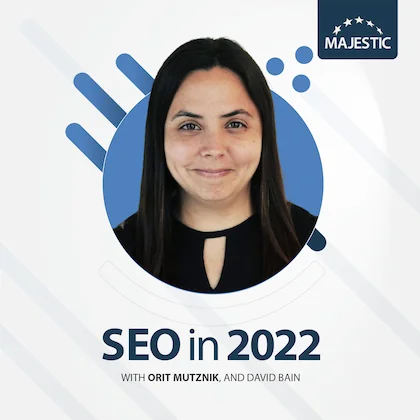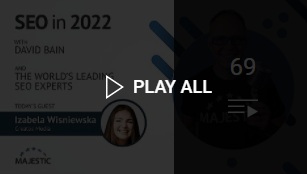-
Site Explorer
- Majestic
- Summary
- Ref Domains
- Backlinks
 New
New Lost
Lost- Context
- Anchor Text
- Pages
- Topics
- Link Graph
- Related Sites
- Advanced Tools
- Author ExplorerBeta
- Summary
- Similar Profiles
- Profile Backlinks
- Attributions
- Compare
-
Link Tools
- My Majestic
- Recent Activity
- Reports
- Campaigns
- Verified Domains
- OpenApps
- API Keys
- Keywords
- Keyword Generator
- Keyword Checker
- Search Explorer
- Link Tools
- Bulk Backlinks
- Neighbourhood Checker
- Submit URLs
- Experimental
- Index Merger
- Link Profile Fight
- Mutual Links
- Solo Links
- PDF Report
- Typo Domain
- Free SEO Tools
-
Support
- Blog

- Support
- Get started
- Tools
- Subscriptions & Billing
- FAQs
- Glossary
- How To Videos
- API Reference Guide

- Contact Us
- About Backlinks and SEO
- SEO in 2024
- Link Building Guides
- Webinars
- Blog
Combine keyword research and keyword clusters with your internal linking strategy to increase your page relevancy
Orit Mutznik
Orit shares that selecting the right keywords and having great internal linking is a winning combination.

Combine keyword research and keyword clusters with your internal linking strategy to increase your page relevancy
Orit says: "Internal linking is the number one strategy, and you just have to be smarter about it in 2022. Keyword clusters is bringing a full set of context onto one page. This is a group of very similar keywords that you can all target in one page. There are tools that can do this, such as Keyword Insights. You plug in a list of keywords and their search volumes, that you can pull up from Semrush or other keyword tools, and the output shows you which cluster would be the most efficient one to use on a specific page. If you create a page using all these cluster keywords together, it's highly likely you will get a boost on your page.
However, it's quite complicated to do because you don't want to get too repetitive and have too much context on the page. This is where internal linking comes in to help you solve this problem. You need to do your keyword research and look at your search volumes relating to the pages you want to create. Then, you take the top searches that are relevant and turn those into your internal links. You create the content based on keyword clusters (the ones you are able to use) but still make the page really accessible, natural-looking, and readable. Everything else you want to add on top of that will be a combination of the remainder of your keyword cluster, and the top searched, most relevant, keywords in that cluster. You will then have the copy written and those internal links.
For an eCommerce site, it's a good idea to have a sort of filter. For example, if you have a page on dresses, you would use context and clusters to create the text in the category page. It's an art because it's something that should be quite short. You don't want to push the products down too much - so you have to prioritise the keywords you use. Additionally, the internal linking complements and creates the filters you want to use. Whatever you couldn't include in the text of the category page, you could include as links to discover more. These links are strategically built based on your keyword research and the clusters you could include. You can do this with every page you link to and have a solid strategy that's very relevant from a clustering and search volume perspective."
I like how you describe it as an art because great SEO is a mixture between art and a science, and the recipe is getting the mixture just right.
"Exactly. Watching Google evolve how it ranks content and evaluates quality over the last decade has been fascinating. It used to be much easier! This is why it has to evolve to the level of art, because we still have the same principles - we want to nail the context and rank. However, now we can't ignore the concept of people as users.
For example, I was frequently pitched by agencies who would tell me to have significantly more content on my category pages to help me rank higher. But I actually disagree with them because the purpose of the content in a category page has to be closely tied to intent - it's a transactional page. The goal of the user is to buy something, so they need context as maybe they found my brand on Google and don't know it. There are a lot of connections and considerations here. Content is also branding, and tone of voice, and other things that maybe are not as often regarded by SEOs.
These are all additional aspects added into tailoring the content. As well as thinking about the most relevant pages for internal links and keywords clusters, consider the user and their intent. They need the right context to tell them they've arrived in the right place and to understand that your brand is trusted. If not, you need very tightly connected contextual links that will get your user to where they want to be. You are effectively tailoring a one-stop-shop."
You said your category pages are transactional - do you not want your transactional pages to be ranked?
"No - I'm just saying the copy doesn't have to be incredibly long. They're already transactional in intent, so just make sure you complete that intent with your copy and include the keyword clusters and internal links that are hyper-relevant to what you're trying to convey."
Is there a maximum number of keywords that should be in a keyword cluster?
"It's very much contextual -I wouldn't put a number on it, especially because it's very dependent on the type of space you have. In a transactional page, you don't have a lot of space, so you don't want to have the products and information down the fold. However, if you have long-form content, you can definitely go wild and use as many keywords clusters as you can. When you have short, limited space, you need to carefully prioritise your clusters and use the ones with the most impact and least effort."
Suppose you've got 10 keyword phrases you want to rank for within your keyword cluster but it's impossible to get them in the conventional areas for SEO. Is it important to have separate pages targeting those keyword phrases? Or is it better to just incorporate them within minor headings and the content further down the page?
"I would refer to this as a developing process. To begin with, I'd attempt to include as many clusters as possible knowing that I haven't included 100% of the clusters. Then, the internal links allow me to have more context without disrupting the flow of the context. You could display them as filters to the page, or as breadcrumbs, for example. This is a way to insert more context into the page and to continue boosting the page. I would also find places to include more parts of the clusters in places like H1s and navigation.
The next stage is to evaluate performance. If the rest of the cluster is important enough, then you could divide that cluster into two and create a different page that you can link from the first page, so the context will remain strong.
Intent is also super important. Both Keyword Insights and Semrush now provide you with the intent - so you have tools to give you all the pieces of the puzzle. This means you can think about taking a different approach to the next page of the cluster. There is a high chance these optimisations will hit the mark because Google is very clever in understanding that even if you only have 10% of the cluster, they'll rank you for the other 90% - especially if the page is technically good."
What does the optimum internal link strategy look like in 2022? You mentioned breadcrumbs as a good way to add internal links and increase page relevancy. What about other internal linking opportunities?
"The ideal would be automation. I'm going to find a way to look at the information architecture of the website and see how I can manage to connect everything together. So internal linking in 2022, for me, is about defining your information architecture in a way that Google would understand. The main weapon of information architecture is internal linking.
It's important to look at the structure of your website. Tools such as Screaming Frog allow you to look at a visual of your hierarchy, so you can see what needs to be improved. Discover which pages don't get enough links inside them, and then do your keyword research to enable you to link to them in a contextually relevant way. Along with the clusters, this approach will help a lot with building your architecture.
Another element of internal linking could be to include lots of automated modules on 'people also like' or 'if you took this course, you might love all of these other courses'. You can slowly cover your entire website in internal linking. Of course, you'll need to have some rules in place, so you don't repeat yourself in every single page to have the same internal linking. There is a way to automate this if the data in the backend has the proper categories and relationships you plan on doing. You can suggest to your readers more relevant content in every place they see.
I'm a big believer in breadcrumbs because I've seen them used as a great way to interconnect your entire website as a whole. Breadcrumbs basically seal the deal and ensure you will never get lost on the website again."
What should an SEO stop doing to spend more time focusing on keyword clusters and internal linking strategy?
"Link building. I'm not saying it's not important - but always prioritise internal linking. No matter how many links you get driving all that link juice, Google will still not fully get your website if it's not interconnected properly. It's not going to discover pages that you don't link to. And no matter how many links you drive into the site, that's not going to help, so focus on having a properly set up architecture with the help of internal linking. Link building can come later to seal the deal."
You can find Orit Mutznik over at forbes.com.
Choose Your Own Learning Style
 Video
Video
If you like to get up-close with your favourite SEO experts, these one-to-one interviews might just be for you.
Watch all of our episodes, FREE, on our dedicated SEO in 2022 playlist.
 Podcast
Podcast
Maybe you are more of a listener than a watcher, or prefer to learn while you commute.
SEO in 2022 is available now via all the usual podcast platforms
Don't miss out
Opt-in to receive email updates.
It's the fastest way to find out more about SEO in 2025.
Could we improve this page for you? Please tell us





